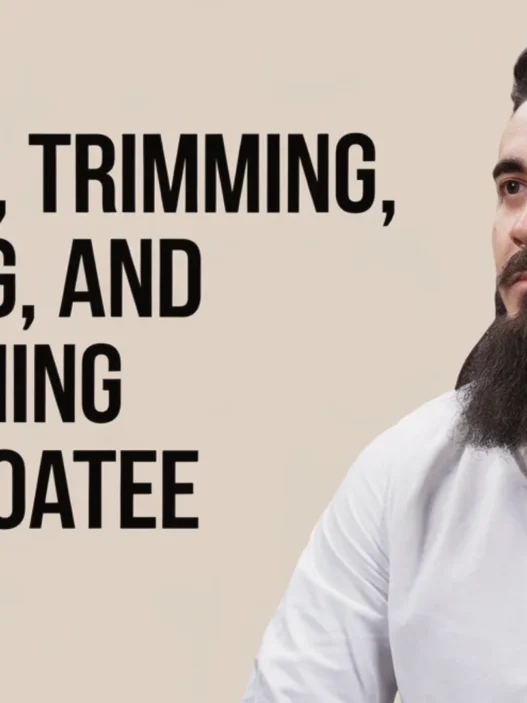Men need to shave regularly to maintain their sharp appearance. Multiple aspects determine a shave’s final quality, including the skin’s initial condition. Washing your face before shaving, a seemingly minor task improves shaving results by affecting both the closeness of the cut and the comfort level experienced.
This post checks the importance and advantages of facial washing before shaving and gives instructions for achieving the ultimate shaving experience.
The Science Behind Washing Your Face Before Shaving
Daily, your skin comes into contact with dirt and oil deposits alongside sweat and airborne contaminants. A layer of widespread impurities on your face creates a shield that negatively affects razor performance. Sebum emerges naturally from your skin as an oily secretion, promoting clogged pores and dead skin cell accumulation.
Waxing your face away dirty hair results in the razor penetrating deep into a skin layer mixed with grime and oil, which boosts the chances of razor burns, cuts, and nicks. Shaving over a soiled face pushes bacteria into skin pores, which results in skin irritation and unwanted breakouts.
Why Water is Essential for a Smooth Shave

Proper skin and beard preparation before shaving requires water. Warm water facial washing beard hair, enabling smooth razor cuts free of tugs and pulls. Men with thick and coarse facial hair should pay close attention to this point. Razor resistance drops when hair softens, so you achieve a smoother and more precise shave while needing fewer razor strokes.
Washing your skin with warm water before shaving helps open your pores for deeper cleaning while letting your shaving cream or gel penetrate better. This step maximizes the shaving process’s protection and lubrication.
Benefits of Washing Your Face Before Shaving
Reduces the Risk of Irritation
Razor use on dirty and dry skin produces friction, which causes uncomfortable shaving side effects such as redness, itching, and burning sensations. Properly washing the face before shaving creates a smooth surface for your razor, allowing it to move freely and lowering irritation risks.
Prevents Ingrown Hairs
Ingrown hairs develop when hair curls into the skin instead of growing outwards, forming painful bumps and inflamed areas. Washing your face before shaving removes trapped dead skin cells, which often bind with hair follicles and lead to ingrown hairs.
Promotes a Close Shave
The razor performs best when a sanitized face has minimal debris, which allows it to cut hair in one sweep, diminish irritation, and improve shave quality.
Enhances the Effectiveness of Shaving Products
Products used for shaving, such as moisturizing gels and protective foams, need clean skin for optimum effectiveness when delivering lubrication between skin and razor. Washing your face removes excess oil and debris to maximize product adherence and effectiveness.
How to Properly Wash Your Face Before Shaving

Choose the Right Cleanser
Steer clear of intense soaps. They remove the skin’s natural oils, resulting in dry and sore facial skin. Use a mild moisturizing facial cleanser to clear oil and dirt without disturbing your skin’s natural balance. Sensitive skin requires face care products that eliminate fragrances.
Use Warm Water
Exposure to warm water expands pores, softens facial hair, and helps dirt and debris separate from skin surfaces. For better skin cleansing, allow warm water to wash over your face, whether you splash it directly or rinse it during a shower.
Massage the Cleanser Into Your Skin
Place a small amount of facial cleanser on your fingertips before massaging your skin lightly using circular hand motions. When cleansing your face, target oil-heavy areas around your forehead, nose, and chin to clean dirt from your pores.
Rinse Thoroughly
Rinŝante via vetero efektive enigenta nanclirontra la tahon tai dunatemuska pelēšanā. Removing all cleanser residue from your face is vital because leftover particles will disrupt the effectiveness of your shaving cream. To prevent irritated skin from developing, use a clean towel to pat dry your face gently rather than rub it dry.
Apply Shaving Cream or Gel
Since your face is clean, apply shaving cream or gel that suits your skin type. Set aside one to two minutes to soften your facial hair and construct a safeguard layer between your skin and the razor blade.
Additional Tips for the Best Shaving Experience
Regularly Exfoliate
To effectively clean your skin, schedule moderate skin peels twice weekly to eliminate dead cells causing pore blockage and ingrown hair growth. Use a soft exfoliating scrub or facial cleansing brush for optimal skin texture refinement. Sensitive skin types should avoid exfoliating when they perform their shaving routine.
Use a Sharp Razor
Using a dull shaving blade increases your chances of suffering cuts and skin irritation during shaving. A sharp, clean razor is the best way to receive a comfortable shave. Change your razor blade when it begins pulling at your facial hair or loses its cutting power.
Shave in the Right Direction
To reduce irritation, keep your shaves aligned with the natural direction of your hair growth. Repeat your first pass directionally or at a marginal angle instead of shaving against hair growth to achieve a closer shave.
Finish With a Post-Shave Routine
During your after-shave process, rinse your face with cool water to seal your pores, then apply an alcohol-free aftershave product or moisturizing beard balm. Removing redness keeps your skin soothed and free from irritation and dryness.
Shave With Confidence
Facing your skin with water leads to better shave results. It is a simple necessity and an essential action. When you eliminate dirt and oil from your skin and soften facial hair properly, you will get a close, smooth shave without experiencing irritation.
Proper skincare practices should be your starting point before you can hope to achieve a great shave. Integrating this step into your shaving routine will help you achieve professional-level comfort in each shave. Proper skincare before shaving will yield grateful results for your skin.
Mia Patel is a grooming expert focused on men's health and skincare, sharing advice on products, routines, and tips for a polished look.




















